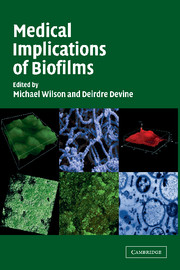Book contents
- Frontmatter
- Contents
- Preface
- List of Contributors
- PART ONE INTRODUCTORY CHAPTERS
- PART TWO BIOFILMS ON PROSTHETIC DEVICES
- PART THREE ORAL BIOFILMS
- PART FOUR BIOFILMS ON SHEDDING SURFACES
- 11 Dissection of the Genetic Pathway Leading to Multicellular Behaviour in Salmonella enterica Serotype Typhimurium and Other Enterobacteriaceae
- 12 Bacterial Growth on Mucosal Surfaces and Biofilms in the Large Bowel
- 13 Pseudomonas aeruginosa Biofilms in Lung Infections
- Index
- References
13 - Pseudomonas aeruginosa Biofilms in Lung Infections
Published online by Cambridge University Press: 23 November 2009
- Frontmatter
- Contents
- Preface
- List of Contributors
- PART ONE INTRODUCTORY CHAPTERS
- PART TWO BIOFILMS ON PROSTHETIC DEVICES
- PART THREE ORAL BIOFILMS
- PART FOUR BIOFILMS ON SHEDDING SURFACES
- 11 Dissection of the Genetic Pathway Leading to Multicellular Behaviour in Salmonella enterica Serotype Typhimurium and Other Enterobacteriaceae
- 12 Bacterial Growth on Mucosal Surfaces and Biofilms in the Large Bowel
- 13 Pseudomonas aeruginosa Biofilms in Lung Infections
- Index
- References
Summary
INTRODUCTION
In 1962, Nobel Laureate Frank MacFarlane Burnet wrote ‘one can think of the middle of the twentieth century as the end of one of the most important social revolutions in history, the virtual elimination of the infectious diseases as a significant factor in social life’ (Burnet, 1962). Indeed, advances in medical technology have come forth at an impressive rate. However, pathogens have adapted to and even taken advantage of the altered host environments created by modern therapies and medical devices, and new forms of microbial infections continue to challenge and confound modern medical technology. Development of microbial resistance to antibiotics and biocide disinfectants represent well-known examples of microbial adaptation. The increasing frequency with which indwelling medical devices, including intravenous catheters, replacement heart valves, prosthetic hip and knee joints, and artificial hearts, are being used represents a tremendous advancement in modern medicine, but it has also afforded certain microbes with a new opportunity to breach the primary host defences and initiate a focal point of infection. These devices penetrate protective dermal or mucosal layers and provide many pathogenic organisms with a surface on which they can attach and grow. The mode of growth that occurs, that of a community of interconnected and communicating cells known as a biofilm, allows a high density cluster of cells in various physiologic states to coexist.
- Type
- Chapter
- Information
- Medical Implications of Biofilms , pp. 287 - 310Publisher: Cambridge University PressPrint publication year: 2003



